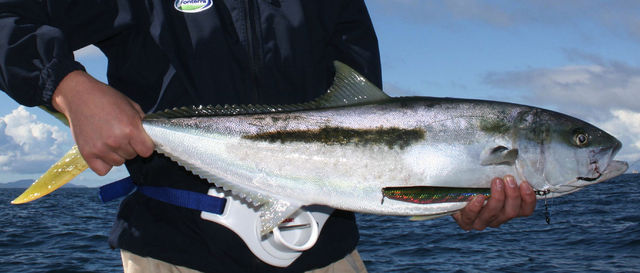Ruakākā in northern New Zealand is honing a multi-billion-NZ-dollar industry via its commercially promising youthful kingfish aquaculture.
The Haku Farm project by the National Institute of Water and Atmospheric Research (NIWA) is readying to overtake farmed salmon revenue with that from cultured kingfish.
Haku, whose name in the Maori means kingfish, anticipates to make the kingfish industry worth NZ$3 billion ($1.73 billion) by 2035.
When the sector rakes in this figure, it will overtake salmon farming, whose Aquaculture Strategy targets NZ$1.5 billion ($865.2 billion) by 2035.
Now maturing, the project has been in preparation for decades, according to Chief Scientist Andrew Forsythe of NIWA Aquaculture.
The Haku facility is currently complementing ocean kingfish supplies of the nearby Bream Bay. It has already harvested 250 tonnes of the fish since it began commercial production in August 2024.
This tonnage could improve to the original intention of 600 tonnes a year, constituting 3 kg to 30 kg fish.
The farm is also courting trade promise from regional countries such as Singapore, whose delegation visited in March 2025.
Foreign interest underlines the pioneer role of the land-based project for the species, as all other kingfish fisheries are offshore.
Kingfish ocean fisheries face total allowable catches (TAC) laws keen to maintain 40% of the original haku reserves before modern fishing began. Rarely does this margin expand, unlike other species such as rock lobster and other fish, whose TACs expanded in March 2024.
For this reason, commercial kingfish fisheries provide a tiny bit of the total catches, for 70% comes from recreational fishermen.
The coming of large-scale kingfish aquaculture facilities like Haku could therefore not only redeem ocean stock limitations but soar earnings. But before this can happen, the species meanwhile continues to enjoy a low place in New Zealand’s fisheries, per the statistics below.
New Zealand Kingfish Statistics
With a land area of 270,534 km2, New Zealand boasts over 169,000 km2 of water area, a source of fin fish and shellfish. The waters nurture over 130 harvested species, 60 of which make the country self-sufficient in fish production. Indeed, the annual per capita supply of fish is high at 67.70 kg, as of 2003, according to the Food and Agriculture Organization (FAO). However, some species such as kingfish (yellowtail) are still under-supplied due to sustainability reasons and dependence on ocean fisheries.
How big are haku exports by New Zealand?
Because kingfish production in New Zealand is a small margin of the total fin fish output, exports are minor. In 2024, live or frozen kingfish totaling 69,565 kg made up 0.65% of all fin fish exports while the prevalent Hoki claimed 22.4%. The tally was way behind the top export, jack mackerel, at 29.2%, according to NZ’s Seafood Company.
What is the status of kingfish aquaculture in New Zealand?
In August 2024, the National Institute of Water and Atmospheric Research (NIWA)’s farm in the Northlands began commercial production. Beforehand, there was virtually no large-scale kingfish aquaculture in the country. The project’s volume intention is for 600 tonnes of fish annually while its financial target is three billion New Zealand dollars by 2035. Towards this goal, NIWA’s Northlands’ hatchery has also a capacity to produce 500,000, scalable to 1 million fingerlings per year.
